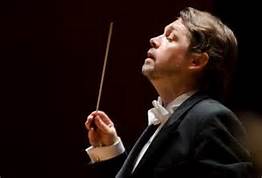Two guest soloists provide extra focus for ISO's Hispanic program
 |
| Andrey Boreyko is music director of orchestras in Belgium and Naples, Fla. |
Andrey Boreyko is the guest conductor, and both major works (in concerts Thursday and Friday nights and this
afternoon at 5:30) have capable soloists: Mark Kosower, principal cellist of the Cleveland Orchestra, is featured in Richard Strauss' "Don Quixote." and mezzo-soprano Barbara Rearick is the soloist in Manuel de Falla's "El amor brujo" (Love the Magician).
Friday's Hilbert Circle Theatre audience was boosted in its response by the presence of the high-school musicians in the Honor Orchestra of America, one of three ensembles that are part of Yamaha's Music for All National Festival. The Honor Orchestra played a short concert before the ISO, and will be featured just after the professional orchestra's concert today.
The enthusiasm was predictably torrential after the performance of Estancia Suite, op. 8a, by Alberto Ginastera, a 20th-century Argentine composer whose centenary is being celebrated this year. You can hardly come up with a classical piece more likely to have you dancing in your seat than the suite's concluding "Malambo," which ended the concert.
The ISO's performance Friday was its first in nearly 50 years of music that celebrates dance types in the composer's homeland. The suite rises inexorably through celebrations involving agricultural workers, a calming "wheat dance," and cattlemen before it attains an orgiastic summit in the finale. The braying horns and onslaught of percussion, brought together in clangorous ensemble with mounting frenzy, characterize a testosterone-fueled gaucho dance that juggles meters and rhythms with abandon.
Estancia capped a concert that included another dance-based composition, the Spanish composer Falla's interpretation of a scenario in which a man's deceased first wife haunts his new relationship. An exorcism clears the way to joy for the new couple, with love indeed being the musician, as the title says. Rearick interpreted the singer's role in four of the work's movements with the "Spanish passion" promised in the ISO's publicity. Her weighty voice projected the Spanish text with conviction, elucidating love's dangers and sorrows before ending with a brief, radiant salute to dawn.
The instrumental portions were smartly evocative, from the familiar "Ritual Fire Dance" through such
 |
| Mark Kosower etched the Don's dreams and defeat well. |
"Don Quixote" is perhaps the most substantial, as well as the most picturesque, of the Strauss tone poems. Its wealth of thematic material and the unabashed realism of its tone painting allow it to communicate much about Cervantes' masterpiece. The adventures of the "man of La Mancha," as a latter-day Broadway hit calls him, along with his sidekick Sancho Panza, were focused on Kosower's insightful portrait of the knight as Strauss interpreted him.
The unusual seating arrangement of the ISO for these concerts, with the first and second violins divided on either side of the conductor, helped clarify the work's thick orchestration of. In addition to a few violin solos by Philip Palermo, acting principal violist Mike Chen was central to Kosower's achievement in the sprightly way he embodied the long-suffering peasant who tries to keep Don Quixote somewhat acquainted with reality.
It's a losing battle, as the music and the novel make clear in their own ways. The episode in which a flock of sheep is scattered, with dissonant "baas" from the winds, provided a piquant glimpse of livestock in panic. In Strauss' time, such symphonic realism was almost scandalous. Another vivid comic touch in Friday's performance was provided by a sinking tuba phrase, followed by an equally dejected contrabassoon, at the end of Don Quixote's failed attack on a pilgrim procession.
Some of the most affecting music in the score is the lengthy Variation III, Strauss' most expansive representation of the Don's "impossible dreams." Swelling phrases that capture the knight's illusions foreshadow the kind of music Strauss was later to write for "Der Rosenkavalier," once he had checked the modernist tendencies he exercised so memorably in "Salome" and "Elektra."
After the rich bassoon duet (representing a couple of conversing monks) came an impressive account of Don Quixote's final conflict, in which the Knight of White Moon meets him on his own fantastic terms and sends him, sore and despondent, back home. The orchestra's steady pulse, bulked up massively, underlines the quester's return to reality and final musings on his deathbed.
This soliloquy was particularly well-rendered by Kosower. His last phrase, opening with a death-rattle vibrato, sank dully through a downward glissando into the devastated relief of nothingness. The orchestra's concluding benediction then crowned a rendition that showed how eloquently a solo cello can stand in for one of world literature's most memorable figures.



Comments
Post a Comment